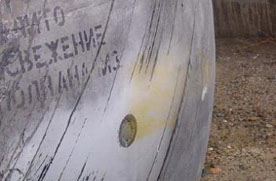From environmental hazard to safe fertilizer
Previously used in small and medium-range missiles by Soviet forces, melange is a highly toxic substance. Thousands of tonnes of melange are still present in several countries of the former Soviet Union and Warsaw Pact. In some places, this highly corrosive fluid is eating through storage tanks and leaking into the ground, polluting the soil and exposing groundwater to possible contamination. Its poisonous red-brown fumes can also cause other problems, such as breathing difficulties and toxic rain.

In Azerbaijan and Uzbekistan, stocks of melange have been neutralized and converted into low-grade fertilizer, thanks to a mobile plant developed with financing from NATO’s Science for Peace and Security (SPS) Programme
“We must ensure that this material returns to the environment in an environmentally friendly way,” says Bülent Tüdes, Programme Manager at NATO’s Maintenance & Supply Agency (NAMSA), which is overseeing implementation of the project,“It would have been an environmental disaster had we not cleaned this”.
A safe and cost-effective solution

Instead, NAMSA developed a way to neutralize the melange in place. By using a plant designed by an American firm and run by a Turkish company, NAMSA was able to bring the neutralization factory to the melange instead of the other way around.
Requiring only two weeks to move (seven days for disassembly and transportation plus another seven days to re-assemble and start up), the melange conversion plant holds the key to decreasing the amount of this dangerous substance.
Laying the groundwork in Azerbaijan
To date, NAMSA has successfully implemented the melange-conversion project in two countries: Azerbaijan and Uzbekistan.
The project in Azerbaijan began in 2006 with the goal of neutralizing nearly 1,300 tonnes of melange stored in Alät and Mingäçevir.
NATO invested 2.2 million Euros in the construction, transportation and assembly of the plant, in addition to the cost for experts and personnel to run it. Using calcium hydroxide to neutralize the nitric acid in the melange, NAMSA converted the toxic substance into a low-grade fertilizer. “This is the safest and most environmentally friendly way to neutralize this very dangerous substance,” says Mr Tüdes.
The plant was capable of converting up to five tonnes of melange per day with additional infrastructure and logistical support provided by Azerbaijan. “We worked together in order to improve their care for the environment,” says Dr Christiaan de Wispelaere, the SPS Advisor responsible for the project at NATO Headquarters.
Adapting the project in Uzbekistan
Following the successful completion of the project in Azerbaijan in 2008,NATO moved the plant to Uzbekistan later in the year. There it permitted the destruction of 1,100 tonnes of melange stored in deteriorating storage containers in the Samarkand region. The project finished in October 2010, ahead of schedule.
Today, the mobile conversion plant remains available for use by other countries with similar needs for assistance.
A multinational effort
In addition to financial and logistical support from sponsoring and host nations, international specialists from Germany, Poland and the United States lent their expertise to the project.
As Dr de Wispelaere points out: “The most important thing with the Science for Peace and Security Programme is collaboration between NATO and partner countries,” he says. “It is about civil cooperation for the benefit of the people.”
